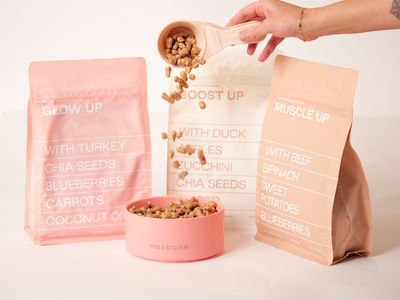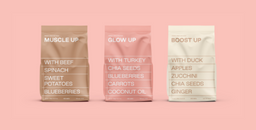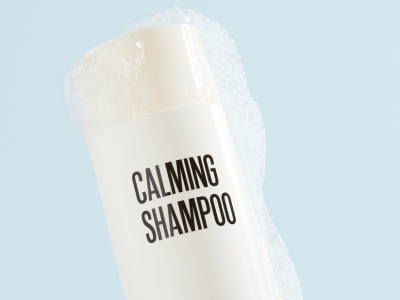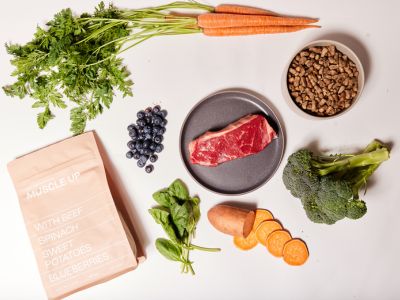Questioning your pet’s nutrition is just good sense. Everything a dog eats or drinks directly affects, not only their behavior, but how well they grow up and avoid any health complications that aren’t already pre-existing. In fact, a supreme diet for your dog can do wonders to gradually turn things around within an internal condition that needs pepper care and attention.
The pet food market is flooded with brands, the latest greatest trends, and science-backed meals that are guaranteed to deliver on promises of overall dog wellness for years to come. But just how much do we need to read labels, do our homework on specific ingredients, determine whether raw versus cooked is better, amounts to feed, etcetera. The list of thought-provoking questions is endless, yet the main concern is to understand that old myths and traditions from the standard, dry, bland, cooked brown kibble days aren’t all they’re cracked up to be.
Let’s explore some of those mainstream ideas that have plagued the pet food and nutrition market and offer up some alternatives that could send your four-legged friend on the road to better health, more energy, proper weight, good dental hygiene, and be part of your family for longer than expected.
The truth about corn in dog food
Processed corn in a bag of dried dog kibble tends to be the second or third ingredient. If it’s the first ingredient on the label, there’s a problem. There’s the pro-corn crowd and the general anxieties from breeders or pet owners who proclaim corn leads to digestion issues and compromised fur coats.
Being an informed consumer is step one. The truth is that some of the exaggerated claims actually originate within the pet food industry. For example, here are some of the myths surrounding corn as a top ingredient in your dog food:
So when it comes to corn as a top inclusion in your dog’s diet, check where it’s listed on the ingredient label and make the decision from that standpoint. There are numerous carbohydrate alternatives that can offer your canine better nutrition, such as sweet potatoes, brown rice, or pureed pumpkin.
Changing your dog’s diet
Most veterinarians now swear by giving your dog different foods as often as possible. The age-old myth that your pet has to eat the same boring food day after day has been shattered a thousand times over. For instance, think about how their bodies are set up and when your canine experiences growth spurts and illness, such as humans do.
Would you want to eat the same food every single day for the rest of your life, no matter what? A dog’s body changes, just as our human bodies do. Granted, their systems aren’t as complex, however, adding specific--and fresh--ingredients to their meals will not only enhance their energy and overall health, but provide a happy tail wag when they understand that the food they’re about to eat is something new.
A varied diet for your dog is essential. Toss out the myth that changing their food will cause digestive disruptions and embrace the idea that mixing it up every so often only enhances a canine’s health.
Because their noses are ten thousand times more in tune than a human’s olfactory senses, the instant they smell a new type of food landing in their bowl as you mix it up, the instant those dog endorphins signal positive wellness to their bodies. It’s a win win.
Raw food versus dry food
The raw food diet industry has skyrocketed as of late, and the reasons are vast. Since dogs have evolved over paleolithic times from their wolf ancestors--who roamed and ate raw meat in the wild--it stands to reason that raw food might be better for your pet than dry food. Here are some classic myths regarding a raw food diet:
All preservatives in foods are created equally
Most chemical additives within dog foods are designed to increase the shelf life of the food and treats. However, knowing which ones are toxic versus which preservatives can actually add some quality to the food is part of the myth. All added dog food ingredients are not created equally.
Chemical additives are known to cause dry skin, allergic reactions, dental disease, and other health issues. Avoid foods that contain chemical preservatives such as BHT (butylated hydroxytoluene), BHA (butylated hydroxyanisole) or ethoxyquin. Instead, look for natural preservatives like vitamin E in mixed tocopherols and vitamin C (ascorbic acid). Both of these latter ingredients will aid in healthy skin, coat, gums, and teeth.
In summary
Getting squared away with truth versus myths, likes versus dislikes, and science versus false claims is the only method to ensuring your dog eats well, behaves accordingly, and lives a long and healthy life.
























